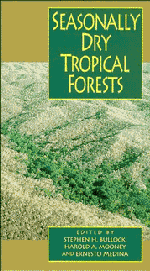Book contents
- Frontmatter
- Contents
- List of contributors
- Acknowledgements
- 1 Introduction
- 2 Dry forests of Central America and the Caribbean
- 3 Overview of the Brazilian caatinga
- 4 Savannas, woodlands and dry forests in Africa
- 5 Dry forest ecosystems of Thailand
- 6 The Cenozoic record of tropical dry forest in northern Latin America and the southern United States
- 7 Diversity and floristic composition of neotropical dry forests
- 8 Vertebrate diversity, ecology and conservation in neotropical dry forests
- 9 Diversity of life forms of higher plants in neotropical dry forests
- 10 Drought responses of neotropical dry forest trees
- 11 Plant reproduction in neotropical dry forests
- 12 Plant–herbivore interactions in Mesoamerican tropical dry forests
- 13 Biomass distribution and primary productivity of tropical dry forests
- 14 Nutrient cycling in tropical deciduous forests
- 15 Biology of the belowground system of tropical dry forests
- 16 Nitrogen trace gas emissions in a tropical dry forest ecosystem
- 17 Conversion of tropical dry forest to pasture and agriculture
- 18 Ethnobotany of the Mexican tropical dry forests
- Index
11 - Plant reproduction in neotropical dry forests
Published online by Cambridge University Press: 07 September 2010
- Frontmatter
- Contents
- List of contributors
- Acknowledgements
- 1 Introduction
- 2 Dry forests of Central America and the Caribbean
- 3 Overview of the Brazilian caatinga
- 4 Savannas, woodlands and dry forests in Africa
- 5 Dry forest ecosystems of Thailand
- 6 The Cenozoic record of tropical dry forest in northern Latin America and the southern United States
- 7 Diversity and floristic composition of neotropical dry forests
- 8 Vertebrate diversity, ecology and conservation in neotropical dry forests
- 9 Diversity of life forms of higher plants in neotropical dry forests
- 10 Drought responses of neotropical dry forest trees
- 11 Plant reproduction in neotropical dry forests
- 12 Plant–herbivore interactions in Mesoamerican tropical dry forests
- 13 Biomass distribution and primary productivity of tropical dry forests
- 14 Nutrient cycling in tropical deciduous forests
- 15 Biology of the belowground system of tropical dry forests
- 16 Nitrogen trace gas emissions in a tropical dry forest ecosystem
- 17 Conversion of tropical dry forest to pasture and agriculture
- 18 Ethnobotany of the Mexican tropical dry forests
- Index
Summary
Introduction
Temporal and spatial patterns of water availability are perhaps the most widespread determinants of the characteristics of tropical vegetation. Both locally and regionally, floristic diversity and composition, growth forms, phenology and demography are largely functions of hydrology. However, few studies have focused on how the reproduction of tropical forest plants changes along a gradient of water stress, except in regard to phenology, despite extensive field studies (especially of floral biology) and many reviews of the literature (e.g. Baker et al., 1983; Bawa & Hadley, 1990). In this review I emphasize comparisons among species and sites in dry forest and, especially, contrasts between drier and wetter localities, with respect to a series of topics. Do differences in water stress correspond to different patterns of mating and of evolutionary mechanisms, as determined by the frequency of sexual types and of self-incompatibility systems? How do the timing and duration of flowering and fruiting change across a gradient in the duration of water stress, and what determines such changes? What changes occur in the spectra of pollen and seed dispersal systems, and of available vectors? Lastly, extending our perspective to life histories raises questions of how reproductive effort changes due to water stress effects on mortality and growth.
This review is drawn from a heterogeneous literature. There are few comparisons of reproductive biology among localities differing in water stress, or in associated species, which focus on intraspecific or intrageneric variation. Thus many comparisons must be attempted on the basis of dissimilar species lists, and in spite of different methods. In a few cases some attention has been given to local differences between dry and moist sites.
- Type
- Chapter
- Information
- Seasonally Dry Tropical Forests , pp. 277 - 303Publisher: Cambridge University PressPrint publication year: 1995
- 74
- Cited by



